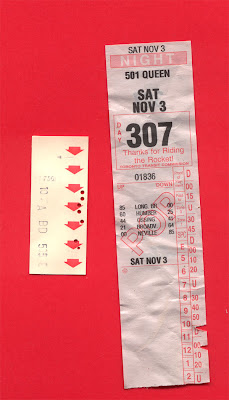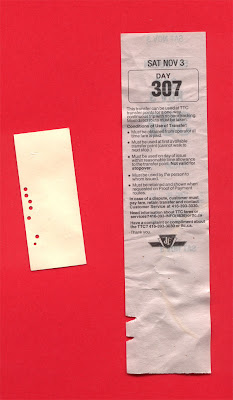French Panic, a local blogger who may or may not be my neighbour, recently spent some time in Toronto. She came back with some pertinent observations about the way that each city’s character manifests itself in bus and subway transfers. Yes, transfers. Read on:
Now, I know it’s dull to compare Toronto and Montreal. They are very different from each other, and shouldn’t be compared. But. These transfers say all sorts of interesting things. The Montreal transfer is devoid of all information, save for a set of arrows to let you know which side to stick in the machine at the metro and a time for when it expires.
But the Toronto transfer is barking information at you. It’s the 307th day of the year! It’s Saturday night! We are the Toronto Transit Commission! Thank you!
When you turn it over, there is the date, the day number, and instructions:
Must be obtained from operator at time fare is paid.
Must be used at first available transfer point (cannot walk to next stop.)
Must be used on day of issue within reasonable time allowance to the transfer point. Not valid for stopover.
Must be issued by the person to whom issued.
Must be retained and shown when requested on Proof of Payment routes.Then some phone numbers — three different ones depending on what your intentions are — the website (twice) — and a final “Thank you.”
The Montreal transfer is completely devoid of information, aside from the holes so that a machine can read it. If the machine chooses to read it.
Montreal gives you no information. It is blank – you can do whatever you want with it, but it’s not going to share any information with you very easily.
Toronto is eager and polite – but fascist, too.
Next spring, after forty years, Montreal will be getting rid of its punch-card transfers by replacing them with magnetic-strip transfers similar to the metro tickets and weekly passes we already use. We’ll shift from 1960s punch-card technology to, uh, 1970s magnetic-strip technology — but will our transfers keep their Montreal spirit?
Photo by French Panic



5 comments
I though the new transport card will be a contactless chip card, and not a magnetic one. If you transfer it’ll read the place where you got on, the time and the type of transport you came from.
But maybe I’m just wrong.
http://www.stcum.qc.ca/English/info/smartcard2008-QA.htm
I’m blushing with all the newfound temporary fake celebrity status that has been thrown at me today. Thank you for the link, “neighbour”!
The contactless smart card will replace the monthly passes. But when you pay cash fare, you’ll get a paper magnetic-strip ticket that can be used for a predetermined amount of time on the bus and metro.
Laval has been using the new transfers for awhile now. The advantage is that they give you unlimited access to the whole transit system for 90 minutes, unlike the current arrangement which only allows you to transfer once from bus to metro, from metro to bus or from one bus line to another.
I’ve found I’ve had a bit of trouble with the punch cards in the past. Once, while on the bus, the machine that gave the transfers stopped working. The bus driver just told me to tell the person at the Metro wicket what happened and he would let me through. I was skeptical but had no choice. I got to the wicket and he wouldn’t let me through. Luckily, I went across the street (at Peel Station) and went to the other wicket where the attendant seemed not to believe me but still let me in. Also, there is the problem of the transfers not working when you put them in the slot at the Metro station. There have been a few times where they couldn’t be read and I had to either try multiple slots or take it to the attendant. Lots of people seem to just abandon their transfers altogether (I’m assuming often because they don’t know about the tray on the side for rejected tickets and transfers) based on how often I see transfers sitting in the tray or half sticking out with the machine making grinding sounds.
As a recent Montreal-to-Toronto transplant, let me register a “meh” to the whole fascist idea. The Montreal transfer has just as much information as the Toronto one — but it’s computer-encoded, so that ordinary humans can’t read what it says. Which would sort of suggest another analysis, if you were really going to analyze things that way. (I wouldn’t.)